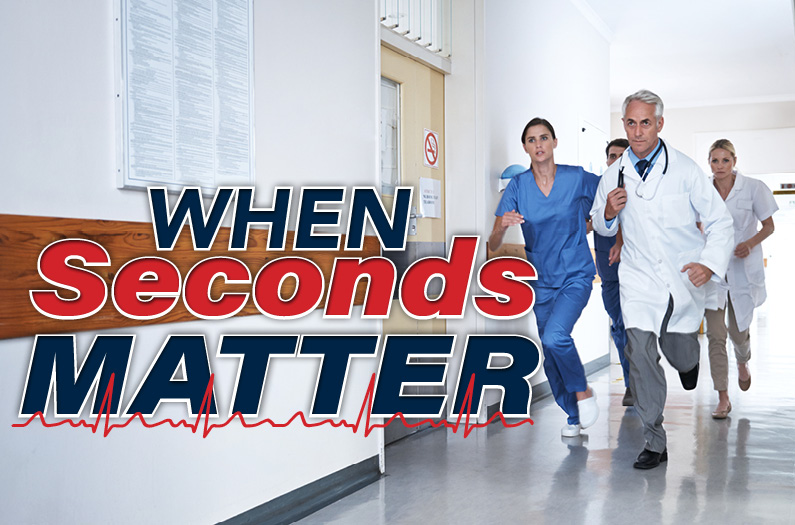When Seconds Matter
Stroke prevention starts with awareness. Discover key risk factors and how different types of strokes affect the brain.

Acute ischemic stroke is the most common type of stroke and occurs when blood flow to an area of the brain is reduced or completely cut off. When blood flow to the brain stops completely or is significantly reduced from normal circulation, brain cells begin to die, and the parts of the body controlled by those areas of the brain are then affected. This is why a stroke can cause difficulties with functions such as speaking, walking, memory, and other physical and cognitive abilities.
There are some potentially treatable stroke risk factors, some being lifestyle factors, and others being medical risk factors.
Lifestyle Risk Factors
-
Being overweight or obese
-
Physical inactivity
-
Heavy or binge drinking
-
Use of illegal drugs such as cocaine and methamphetamine
Medical Risk Factors
-
Cigarette smoking or exposure to secondhand smoke
-
Cardiovascular disease, including heart failure, heart defects, heart infection, or irregular heart rhythm (atrial fibrillation)
-
Personal or family history of stroke or heart attack
Other Factors
-
Age – People 55 years of age or older are more likely to experience a stroke
-
Race or ethnicity – African American and Hispanic individuals are at higher risk for stroke
-
Sex – Men are at a higher risk of having a stroke, though women are typically older when they have strokes and experience higher fatality rates
-
Hormones – Birth control pills and other hormone therapies with estrogen increase stroke risk
Acute ischemic stroke is the most common type, accounting for approximately 87% of all strokes. Transient ischemic attacks (TIAs), often called “mini-strokes,” are milder versions. Other types of strokes include hemorrhagic strokes and cryptogenic strokes.
Most Common Types of Strokes
Acute ischemic stroke (approximately 87% of all strokes) – Caused by a blockage of an artery (or, more rarely, a vein), which prevents blood flow to the brain.
There are two main types of ischemic stroke:
- Thrombotic stroke – Caused by a blood clot that forms within the blood vessels of the brain
- Embolic stroke – Caused by a blood clot or plaque debris that forms elsewhere in the body and travels to the brain through the bloodstream
- Hemorrhagic stroke (approximately 13% of all strokes) – Caused by bleeding when a weakened blood vessel ruptures.
There are two main types of hemorrhagic stroke:
- Intracerebral hemorrhage – Bleeding from the blood vessels within the brain
- Subarachnoid hemorrhage – Bleeding in the space between the brain and the membranes covering it
Other Types of Strokes
Transient ischemic attack (TIA) – Often called a “mini-stroke,” which causes a temporary period of symptoms like a stroke but does not cause permanent damage. Even though symptoms may disappear, you should still seek emergency care with a TIA!
Time = BRAIN
Every type of stroke is considered a medical emergency as swift medical attention is crucial to achieve the best quality of life possible post-stroke. This is why it is important to be aware of the signs and symptoms of a stroke as soon as possible.
Memorial Health System (MHS) has adopted the B.E. F.A.S.T. method for noticing the signs and symptoms of a stroke emergency:
B – Balance Loss; loss of balance or dizziness
E – Eyesight Change; sudden vision loss in one or both eyes
F – Face Drooping; one side of the face droops or is numb
A – Arm Weakness; one arm (or leg) is weak or numb
S – Speech Difficulty; slurring of speech, inability to speak, difficulty understanding
T – Time to Call 9-1-1; even if the symptoms go away, call for an ambulance!
With stroke being the fifth leading cause of death in Ohio, and the sixth in West Virginia, our region sees an even higher rate of stroke above the national average. At Memorial Health System, our mission is to ensure that our community receives the best care possible for all their healthcare needs, especially for life-altering health emergencies such as having a stroke. And while stroke is not something that is often expected, MHS Neurologist, Neurohospitalist, and Stroke Director, Daniel E. O’Connell, MD, MPH makes certain that patients are treated with the leading therapies of stroke care innovation.
Featured From This Issue
-
Spring 2025
Straight From the Expert: Dr. O'Connell on TNKase for Acute Ischemic Stroke
-
Spring 2025
Built For a Lifetime of Adventure
-
Spring 2025
Expressions of Gratitude: Brenda Paden
-
Spring 2025
Osteoporosis: Q&A With Angela Miller, DNP
-
Spring 2025
LiveMemorialWell: Move It To Lose It with Deanna Schuler!
-
Spring 2025
Respiratory Illnesses on the Rise: What You Should Know
-
Spring 2025
Memorial Health Foundation: 2023-2024 Fiscal Year in Review




